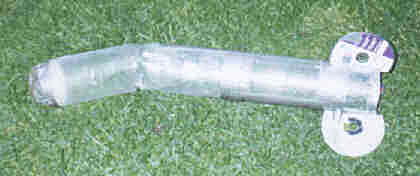|
Water Rocket
Recovery Systems Index
Sending
several hours work up into the sky is a very
exhilerating experience - especially if it stays
up there for a long time. But, unless you find a
way of sending them into orbit, they have to come
down at some point and the higher they go, they
harder they fall.
This
index covers some of the so-called recovery
systems that are used to allow a softer landing
with, hopefully less damage to all of your hard
work.
Ideally, your rocket will be
aerodynamically sound.  Its low coefficient of drag will let
it get to a great altitude but, having got it there,
you need something to slow it down - not doing so
lets the 1½litre
'Egglofter' rocket hit the ground at
around 50mph and the 4
litre, 2 bottle rocket goes so fast that
it is quite capable of bending the front bottle. Some
way of increasing its coefficient of drag is required
from the highest point of the flight (apogee)
is one alternative, cushioning the impact is another. Its low coefficient of drag will let
it get to a great altitude but, having got it there,
you need something to slow it down - not doing so
lets the 1½litre
'Egglofter' rocket hit the ground at
around 50mph and the 4
litre, 2 bottle rocket goes so fast that
it is quite capable of bending the front bottle. Some
way of increasing its coefficient of drag is required
from the highest point of the flight (apogee)
is one alternative, cushioning the impact is another.
Parachute
Systems
Parachutes
There are three parachutes considered here;
- Circular
Bin-Liner parachutes (30
grammes weight - shroud + cords et cetera)
- look
at the pictures; and,
- Circular
Nylon parachutes (50
grammes weight - shroud + cords et cetera).
The extra 20 grammes accounts for a loss
of around 1% of height in the flight. It
also amounts to less than 1/8th
inch of water in the rocket - well within
experimental error - look
at the pictures.
Both are essentially of the same design but
using different materials. The bin-liner type is
quicker and easier to make but is not as strong.
The nylon type is more of an investment of time
and involves solving some techical problems
regarding sewing (explained). Find your
feet with the bin-liner and then move onto the
nylon.
 Parafoil
chutes. Very interesting,
esoteric design that could contribute to
greater downrange distances if trimmed
correctly - it is also possible to trim
it so that it ends up at the launcher.
Again, made from nylon - look
at the pictures. This type
of chute does not give such great 'in the
air' times as a circular chute and it
even weighs more (80 grammes weight -
shroud + cords et cetera) but what
it lacks in time aloft, it makes up for
in wow factor. Parafoil
chutes. Very interesting,
esoteric design that could contribute to
greater downrange distances if trimmed
correctly - it is also possible to trim
it so that it ends up at the launcher.
Again, made from nylon - look
at the pictures. This type
of chute does not give such great 'in the
air' times as a circular chute and it
even weighs more (80 grammes weight -
shroud + cords et cetera) but what
it lacks in time aloft, it makes up for
in wow factor.
Release
Mechanisms
Deploying the parachute at the
correct time is a great problem. Too early and it
never gets as high as it was going to - too late
and the might not have a chance to slow down the
rocket's decent. Timing depends upon what you
want. A long time in the sky (the object of
some competitions) required deployment high
up whereas a soft landing (always required)
merely needs full deployment and a chance to slow
down before impact. Read a discussion
of the pros and cons of the various methods.
Nose
Separates at Apogee (NSA)
. Mounted in the nose cone, the
parachute is deployed at the highest
point in the flight and the rocket stays
in the air for the longest time. Mounting
the nose cone with the parachute inside
it on the base unit is exceptionally easy
as the operations of parachute packing
and mounting are kept separate - it is as
simple as screwing the top onto a bottle.
Also discussed on this page are some
parachute packing strategies and how to
use Talcum powder or PTFE
Sheet.
Non-metalic
timers. Looking at the rules put
out for Science Olympiads, metal is not
allowed therefore some other ideas have
to be used.
Wind Resistance Flap. A
flap sticks out and at launch is pushed
back where is stays until the wind speed
drops sufficiently to allow it to move
out - this time to deploy the patachute.
This method is described on Dave Johnson's page
which describes the release mechanism
amongst other things.
Tomy timers. These
small, spring/escapement mechanical
timers are used to time the deployment of
parachutes (second and subsequent
stages in multistage rockets and so on).
Bruce Berggren's pages
show (amongst other things) how
to use a small clockwork motor as a timer
to deploy further stages as well as
parachutes.
Balloon release. This
has a balloon in the nose cone that is
large enough to push the nose cone off
the front of the rocket. It utilises the
fact that the bottles used in water
rockets come in slightly different sizes
so, having a nose cone that will slip off
the front of the rocket (forced by
the balloon) allows the deployment
of the parachute. The clever bit of this
is that the pressurised bottle expands
because of the pressure inside it
trapping the nose cone on top.
A flight would happen by putting the
balloon into the nose cone, then the
parachute and then pushing this down onto
the top of the rocket. Then the rocket is
pressurised thus gripping the nose cone.
The rocket is launched and when
sufficient pressure inside the rocket has
gone, the balloon can start pushing the
cone off as air starts to leak in. If
this leaking action is timed correctly,
(it can be speeded up by making more
small holes in the nose cone) the
parachute will be deployed at apogee. To
see details of this device, look at Gary Ensmenger's Bigfoot
site.
Drag
Systems
These are systems for increasing the
drag but are not strictly parachutes.
Ribbon. This
is deployed at apogee and flaps in the air on
the way down thus creating drag in the same
way that a flag does in the wind. They can be
deployed in the same way as the parachutes
above.
Air Brakes
are used to slow down the decent of the
rocket. These large flaps are deployed at
apogee and the rocket falls slowly to the
ground.
Ball or cone.
Destroying the aerodynamics of the rocket by
using a ball or cone that falls off at apogee
- the rocket floating down on its side.
Tumble
Recovery
Nose Weight Loss.
Simply, this is where the nose weight is
water that allows the rocket to be stable on
the way up but empties out on the way down so
that the Cp - Cg stability is lost by the Cg
moving aft by the loss of the weight of the
water.
To effect this, have the top part of a bottle
on the top of a rocket (acting as a cone) and
add sufficient water to make the rocket
stable. The hole(s) in the cone should be
large enough to let the water out quickly on
the descent so that stability is lost well
above ground level. If this occurs correctly,
the rocket should lose stability and tumble
to earth (remember that it weighs less as
well so there is not quite as much energy to
dispose of at impact due to two factors: loss
of mass; and, loss of speed.
Wings
Cushioning
Devices
The damage to the rocket happens
because it has such a short distance to slow down -
literally the height of the grass. The energy that
has to be absorbed in such a short period of time
causes plastic deformation of the front of the
rocket. Lengthening this time period or allowing the
energy to be stored in the form of elastic
deformation will improve the longevity of the rocket.
Rubber
ball nose. A rubber ball, such
as a tennis ball, is taped to the nose of the
rocket - couldn't be easier. On impact, the
ball compresses, lengthening the duration of
impact - the rocket simply bounces and lands
from a lower altitude.
Foam rubber 'bounce'
cone. A foam rubber nose cone that
hits the ground first. Again, no problems
regarding the timing of parachute deployment
and the rocket retains its aerodynamic
properties. Once again, the rocket bounces,
landing from a lower altitude.
Retro-Rocket.
A small water rocket mounted in the nose (a)
is triggered by proximity to the ground,
providing a short, reverse-thrust. A seal in
a pressurised bottle is broken when the end
of a rod attached to it touches the ground (b)
- pushing it inside the bottle (c),
releasing water to provide the reverse thrust
and hopefully reducing the velocity of the
rocket to one that will not damage the rocket
by the time it hits the ground (d).
Although I have not built this yet (soon,
I hope - I am currently trying to find some
19mm plastic tubing that will withstand about
5 Bar), I have done some computer
modelling looking at capacity, rod diameter,
pressure, weight, mass of water and so on.
You can download this to play around with
yourself. Click here to download from this
site the Lotus 1-2-3 97 spreadsheet
(h2orretro.123) zipped up (h2orretro.zip -
32,630 bytes).
MD5
hash = 4d961cce3f93aac3bca4216273abbf69
| Thanks to
the following group members (in alphabetical order)
for their help and suggestions: Bruce Berggren; Bill
Clagett; Ian Clark; Randy Crawford; Jim Gage; Carl
Geisser; Clifford Heath; Bruce Johnson; Dave Johnson;
Patrick Matthews; Gordon McDonough; and, Don Wilkins.
|
 |
|
Here's a rocket that you needn't worry about :-)
|
|
 Back to the Main Water Rocket Index Back to the Main Water Rocket Index

FastCounter by
bCentral
|
|